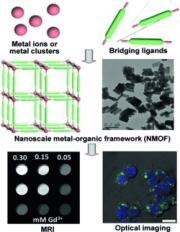Home > Press > Smaller and Sharper
 |
Abstract:
Nanoscale Metal-Organic Frameworks (NMOFs) as MRI Contrast Agents
Smaller and Sharper
Weinheim, Germany | Posted on July 8th, 2010Developing more sensitive methods of biomedical imaging that are effective with minimal amounts of contrast agents is an important challenge in the early and accurate diagnosis of illnesses. A new class of materials that appear promising in this quest were introduced in 2006 by Prof. Wenbin Lin of the University of North Carolina at Chapel Hill. Ever since, this emerging area has been growing rapidly as new materials with improved properties are discovered. Wenbin Lin and Joseph Della Rocca present the progress in this field in the Microreview published in the European Journal of Inorganic Chemistry.
Magnetic resonance imaging (MRI) is a noninvasive technique based on the detection of nuclear spin reorientations in a magnetic field, which, however, is relatively insensitive and typically relies on large doses of administered contrast agents to distinguish adequately between normal and diseased tissues. Nanoscale Metal-Organic Frameworks (NMOFs) are combinations of metals and organic molecules on the nanoscale that provide unlimited possibilities for designing task-specific molecules. They are intrinsically biodegradable, and their high porosity makes them ideal for targeted delivery of entrapped agents. They can be specifically targeted to certain regions of the body. In addition to a wealth of applications in other fields, these properties make NMOFs also very suitable for use in biological systems and in particular as more effective contrast agents at lower doses. In addition to Gd carboxylate materials, NMOFs based on Fe, Mn, and Zn were investigated. Coatings such as amorphous silica, biocompatible polymers, and polyoxometalate-peptide hybrid spheres were used to enhance the stability, dispersibility, and biocompatibility of NMOFs. Furthermore, some systems doped with lanthanides were studied as potential multimodal contrast agents.
The in vivo and in vitro effectiveness of these agents has been demonstrated. For example, iron carboxylate NMOFs modified with biocompatible polymers were used for imaging the liver and spleen of Wistar rats. Silica-coated, peptide-targeted Mn NMOFs were shown to be selectively taken up by a human colon cancer cell line in vitro. Finally, a versatile iron carboxylate system post-synthetically modified to contain a fluorophore or a chemotherapeutic showed strong fluorescence upon release from the framework and exhibited cytotoxicity comparable to cisplatin against colon cancer cells.
Author: Wenbin Lin, University of North Carolina, Chapel Hill (USA), www.unc.edu/~wlin/
Title: Nanoscale Metal-Organic Frameworks: Magnetic Resonance Imaging Contrast Agents and Beyond
European Journal of Inorganic Chemistry, Permalink to the article: dx.doi.org/10.1002/ejic.201000496
####
For more information, please click here
Copyright © European Journal of Inorganic Chemistry
If you have a comment, please Contact us.Issuers of news releases, not 7th Wave, Inc. or Nanotechnology Now, are solely responsible for the accuracy of the content.
| Related News Press |
News and information
![]() Simulating magnetization in a Heisenberg quantum spin chain April 5th, 2024
Simulating magnetization in a Heisenberg quantum spin chain April 5th, 2024
![]() NRL charters Navyís quantum inertial navigation path to reduce drift April 5th, 2024
NRL charters Navyís quantum inertial navigation path to reduce drift April 5th, 2024
![]() Discovery points path to flash-like memory for storing qubits: Rice find could hasten development of nonvolatile quantum memory April 5th, 2024
Discovery points path to flash-like memory for storing qubits: Rice find could hasten development of nonvolatile quantum memory April 5th, 2024
Possible Futures
![]() Discovery points path to flash-like memory for storing qubits: Rice find could hasten development of nonvolatile quantum memory April 5th, 2024
Discovery points path to flash-like memory for storing qubits: Rice find could hasten development of nonvolatile quantum memory April 5th, 2024
![]() With VECSELs towards the quantum internet Fraunhofer: IAF achieves record output power with VECSEL for quantum frequency converters April 5th, 2024
With VECSELs towards the quantum internet Fraunhofer: IAF achieves record output power with VECSEL for quantum frequency converters April 5th, 2024
Academic/Education
![]() Rice University launches Rice Synthetic Biology Institute to improve lives January 12th, 2024
Rice University launches Rice Synthetic Biology Institute to improve lives January 12th, 2024
![]() Multi-institution, $4.6 million NSF grant to fund nanotechnology training September 9th, 2022
Multi-institution, $4.6 million NSF grant to fund nanotechnology training September 9th, 2022
Nanomedicine
![]() New micromaterial releases nanoparticles that selectively destroy cancer cells April 5th, 2024
New micromaterial releases nanoparticles that selectively destroy cancer cells April 5th, 2024
![]() Good as gold - improving infectious disease testing with gold nanoparticles April 5th, 2024
Good as gold - improving infectious disease testing with gold nanoparticles April 5th, 2024
![]() Researchers develop artificial building blocks of life March 8th, 2024
Researchers develop artificial building blocks of life March 8th, 2024
Announcements
![]() NRL charters Navyís quantum inertial navigation path to reduce drift April 5th, 2024
NRL charters Navyís quantum inertial navigation path to reduce drift April 5th, 2024
![]() Discovery points path to flash-like memory for storing qubits: Rice find could hasten development of nonvolatile quantum memory April 5th, 2024
Discovery points path to flash-like memory for storing qubits: Rice find could hasten development of nonvolatile quantum memory April 5th, 2024
Nanobiotechnology
![]() New micromaterial releases nanoparticles that selectively destroy cancer cells April 5th, 2024
New micromaterial releases nanoparticles that selectively destroy cancer cells April 5th, 2024
![]() Good as gold - improving infectious disease testing with gold nanoparticles April 5th, 2024
Good as gold - improving infectious disease testing with gold nanoparticles April 5th, 2024
![]() Researchers develop artificial building blocks of life March 8th, 2024
Researchers develop artificial building blocks of life March 8th, 2024
|
|
||
|
|
||
| The latest news from around the world, FREE | ||
|
|
||
|
|
||
| Premium Products | ||
|
|
||
|
Only the news you want to read!
Learn More |
||
|
|
||
|
Full-service, expert consulting
Learn More |
||
|
|
||








